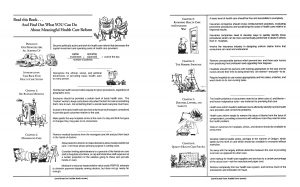In Modern Medicine: What You’re Dying to Know, we talked about the high cost of technology because this was about the time hospitals were jumping on the MRI bandwagon. Some readers may remember the brouhaha over the cost of MRI machines when they first became available to hospitals.
In our book we addressed seven notions we considered myths:
1. Health insurance is expensive because consumers overuse health care services.
2. The cost of technology drives up the cost of medical care.
3. There is a nursing shortage.
4. Doctors control the cost of health care.
5. Malpractice suits are increasing because doctors today are more negligent than before.
6. Peer review is effective in protecting patients from negligence.
7. Efforts to control health care costs by reducing hospital stays are effective.
For each myth, in this case #2, how the use of technology drives up the cost of medical care, we wrote about what the truth was, discussed why the myth prevailed, and suggested a solution.
 Opening image in new window enlarges view to 100 percent
Opening image in new window enlarges view to 100 percent
The Cost of Technology Drives up the Cost of Medical Care (Myth #2)
Truth
It’s not the technology, but the unnecessary duplication of equipment and services that drives up the cost of medical care.
Discussion
Any unmet costs of the new health care technologies are simply passed on to the consumer as increases in insurance rates. When hospitals and clinics invest in duplicate technology such as magnetic resonance imaging (MRI), they seldom need to demonstrate the need for the equipment, and they are not required to demonstrate that the equipment will generate the income to cover its cost.
With no regulation of capital expenses for hospitals and clinics, there is no requirement to make the acquisition of new technology cost effective. Any unmet costs of the new technology are simply passed directly to the consumer in the form of increased insurance rates.
Solution
Services should not be duplicated without need and should be cost effective. If the new technology will not pay for itself as a capital investment, hospitals and clinics should not be allowed to pass this cost on through to consumers in the form of higher insurance rates.
Note: If this presentation of the problem seems a bit simplistic, remember that it’s now over 20 years old. Modern Medicine was written in an attempt to give health care consumers some notion of what was going on with skyrocketing health care costs.
Of course, readers here might notice that the game hasn’t changed much in all these years.


